United Kingdom Aesthetic Devices Market Size
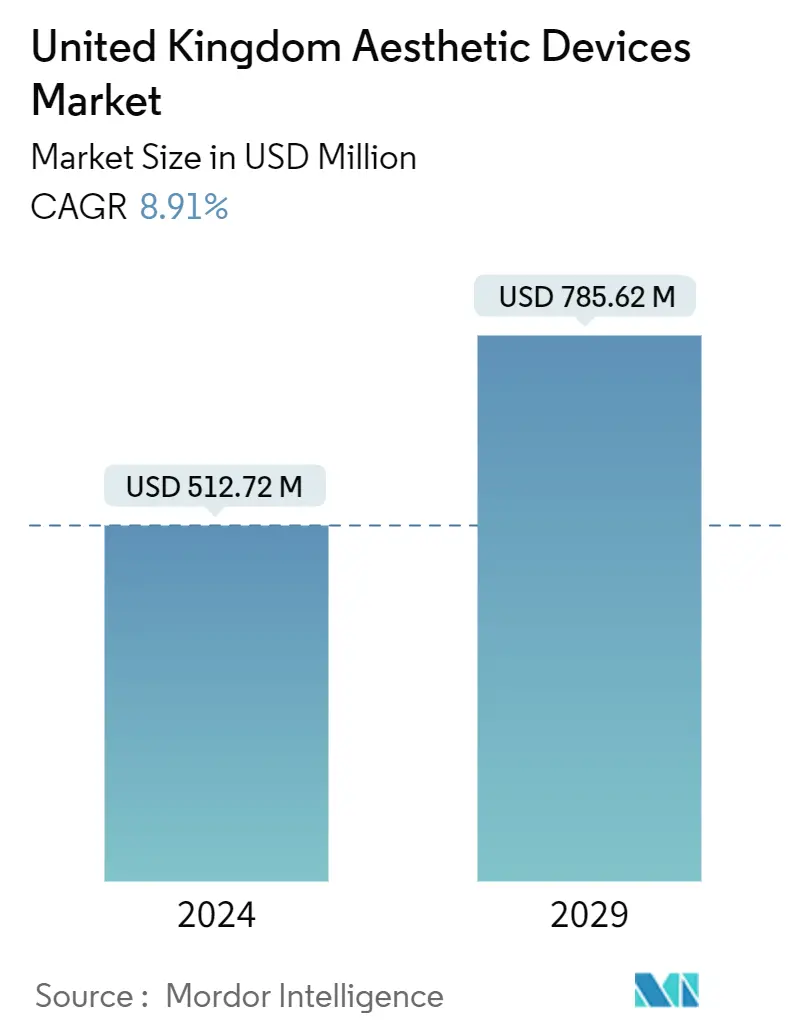
| Study Period | 2019 - 2029 |
| Base Year For Estimation | 2023 |
| Market Size (2024) | USD 512.72 Million |
| Market Size (2029) | USD 785.62 Million |
| CAGR (2024 - 2029) | 8.91 % |
| Market Concentration | High |
Major Players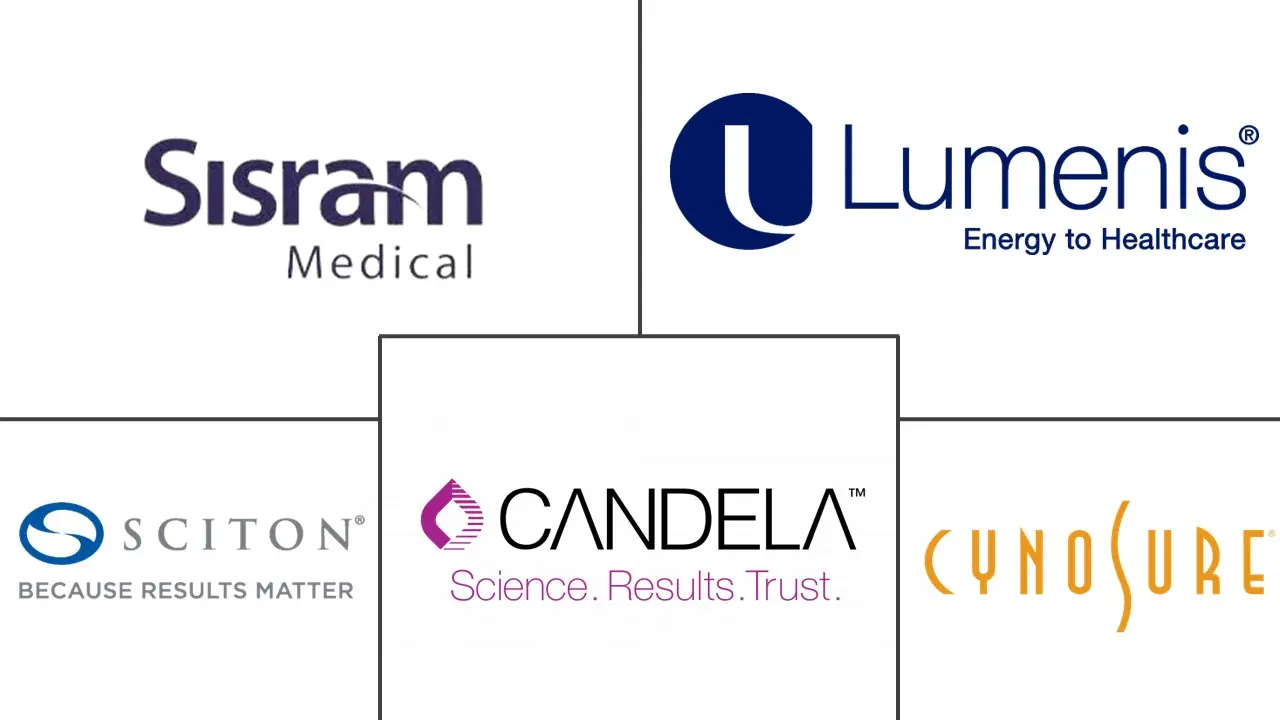
*Disclaimer: Major Players sorted in no particular order |
United Kingdom Aesthetic Devices Market Analysis
The United Kingdom Aesthetic Devices Market size is estimated at USD 512.72 million in 2024, and is expected to reach USD 785.62 million by 2029, growing at a CAGR of 8.91% during the forecast period (2024-2029).
The United Kingdom Aesthetic Devices market is undergoing notable growth, driven by key macroeconomic factors and consumer trends. The rising demand for non-invasive cosmetic procedures, coupled with advancements in technology and shifting demographics, forms the backbone of this expansion. Several influential trends, including the increasing obese population, heightened awareness about aesthetic treatments, the rapidly aging population, and continuous technological progress, are fueling market development. These drivers work synergistically, creating a strong foundation for sustained growth. As UK consumers become increasingly health-conscious and appearance-focused, the demand for aesthetic devices continues to accelerate, encouraging innovation and expanding the market.
Increasing Obese Population: Obesity is emerging as a critical factor in the UK's aesthetic device market growth. According to the National Health Service's Health Survey for England, 26% of adults in England are obese, with 69% of men and 59% of women classified as overweight or obese. Such high obesity rates are boosting demand for body contouring and cellulite reduction procedures. The Office for Health Improvement and Disparities reports that over 25% of UK adults are affected by obesity, a trend extending beyond older adults, with 12% of 18-24 year-olds and 21.8% of 25-34 year-olds also obese. As obesity becomes prevalent across all age groups, the demand for aesthetic devices, particularly for weight management and body sculpting, is projected to rise.
Growing Awareness about Aesthetic Procedures: A significant rise in awareness about aesthetic procedures has fueled the UK's aesthetic device market. The British Association of Aesthetic Plastic Surgeons (BAAPS) reports that over 15,000 cosmetic procedures are performed annually, with breast augmentation leading the way at 4,000 procedures. The surge in demand for aesthetic treatments is partly driven by the pandemic's rise in video conferencing, making people more conscious of their appearance. Additionally, the UK boasts approximately 600 aesthetic surgeons, representing 1.4% of the global total. During the COVID-19 pandemic, The Guardian noted a 70% increase in requests for video consultations for cosmetic procedures. This growing interest is expected to sustain the market's upward trajectory.
Rapidly Increasing Aging Population: Demographic shifts, particularly the aging population, are another key driver in the UK's aesthetic devices market. According to the Office for National Statistics, the UK’s population is expected to exceed 69.6 million by 2029, with one in four individuals aged 65 and older by 2050. This shift is driving demand for anti-aging aesthetic devices and treatments aimed at addressing wrinkles, skin laxity, and age spots. The Health Foundation projects that within the next 25 years, the number of individuals aged 85 and above will double to 2.6 million, further expanding the market for age-related aesthetic procedures.
Rapid Technological Advancements: The UK’s aesthetic devices market is heavily influenced by continuous technological innovations that enhance the effectiveness, safety, and accessibility of aesthetic procedures. Notable developments, such as Emsculpt’s HIFEM technology for muscle building and Lumenis's Splendor X for hair removal, underscore the sector's rapid pace of innovation. Companies like BTL Group and Lumenis are introducing cutting-edge technologies, including the Exilis Ultra360 and Splendor X, which offer enhanced body contouring, skin tightening, and hair removal solutions. These advancements are reshaping patient expectations, broadening treatment options, and contributing to market growth.
These interconnected drivers—changing demographics, growing awareness, technological advances, and health trends—are creating a robust foundation for the continued growth of the UK aesthetic devices market. As consumers seek more advanced treatments with minimal downtime, and companies continue to push technological boundaries, the market is expected to see sustained growth in the coming years.
United Kingdom Aesthetic Devices Market Trends
Non-energy-based Aesthetic Devices: The UK Market Leader Segment Dominance
Non-energy-based aesthetic devices, such as botulinum toxin, dermal fillers, and chemical peels, are dominating the UK aesthetic devices market. These products offer effective, minimally invasive treatments for a range of cosmetic concerns with little recovery time, making them the preferred choice for many consumers. Accounting for approximately 74% of the market, this segment's dominance reflects the popularity of non-invasive procedures among UK consumers.
Driving Forces: Several factors are propelling the growth of non-energy-based aesthetic devices. The UK’s aging population, combined with increasing awareness of aesthetic treatments, is leading more individuals to seek non-invasive solutions. Additionally, technological advancements are improving the efficacy and safety of these devices, broadening their appeal. As societal acceptance of cosmetic enhancements grows, so does demand for procedures offering subtle, natural-looking results. These factors ensure the continued expansion of this market segment.
Market Strategies: Companies are focusing on innovation and training to maintain a competitive edge. The development of longer-lasting fillers and products offering more natural results is a key priority. Strategic partnerships, like collaborations with clinics to improve device training, are also becoming more common. With the potential disruption from emerging regenerative medicine technologies, companies must remain agile, investing in R&D to adapt to future changes in the landscape.
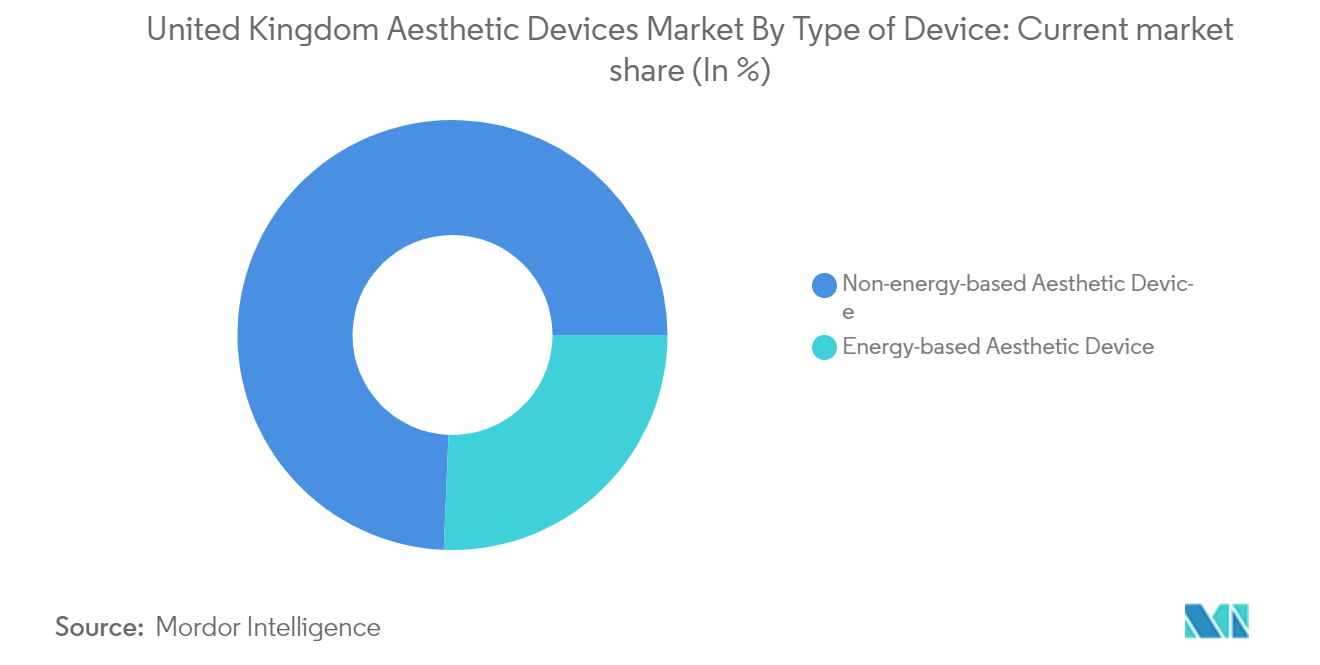
Hospitals: The Rising Star in Aesthetic Device Utilization Segment Growth
Hospitals are quickly becoming significant players in the UK aesthetic devices market. Their established infrastructure and expertise allow hospitals to offer a range of aesthetic services, particularly for more complex procedures that benefit from the safety and reliability of a hospital setting. This segment is forecasted to grow by 7% annually between 2024 and 2029, outpacing other end-users.
Market Catalysts: The integration of aesthetic treatments into traditional medical care is a driving force behind hospitals' growing presence in the market. Patients increasingly prefer hospital-based procedures for their perceived safety and higher standard of care, especially for more invasive treatments. Hospitals are also leveraging their reputation for cutting-edge technology and skilled staff to offer high-end aesthetic treatments.
Competitive Landscape: To stay competitive, companies are developing aesthetic devices tailored specifically for hospital use, ensuring compatibility with existing systems and incorporating advanced safety features. Collaborations between hospitals and manufacturers are becoming more common, enabling innovation and improving treatment outcomes. However, hospitals must be mindful of emerging competition from specialized clinics and evolving regulations that could affect their position in the market.
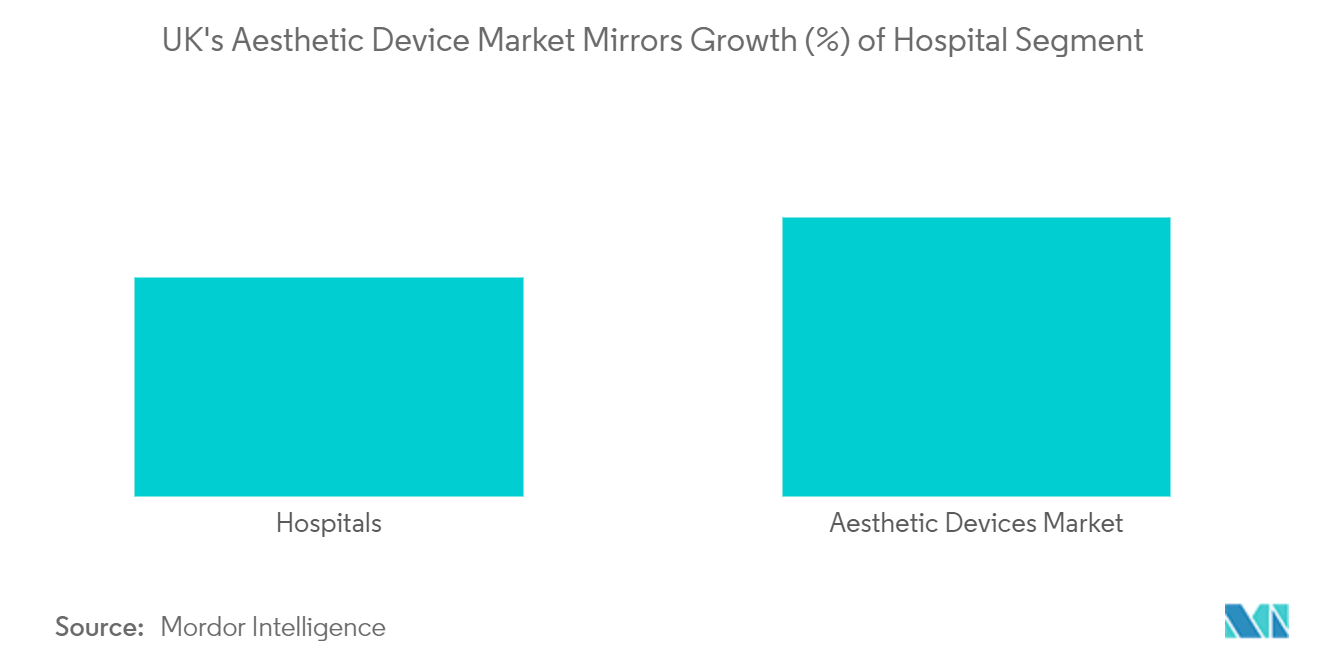
United Kingdom Aesthetic Devices Industry Overview
The UK Aesthetic Devices Market is marked by the dominance of global companies, creating a highly consolidated landscape. Major players like Sisram Medical, Bausch Health Companies, Cutera, Candela, and Cynosure command significant market share through strategic investments and a robust presence in the region. Their ability to adapt to market demands and introduce new products is key to their leadership positions.
Market Leaders: Innovation and Diverse Product Portfolios
The leading companies in the UK aesthetic devices market share a focus on R&D, continuously launching new products that meet consumer needs. Cynosure, for instance, recently launched the Elite iQ Aesthetic Workstation in Europe, and Sciton introduced its mJOULE platform in the UK. These innovations, alongside comprehensive product portfolios that cover everything from skin resurfacing to body contouring, have helped these companies maintain their market leadership.
Strategies for Future Success: Technological Advancements and Market Expansion
For companies to expand their market share in the UK, ongoing investment in technology is essential. The rapid evolution of laser-based and energy-based aesthetic devices requires continuous innovation. Market players should also consider expanding their portfolios through strategic partnerships or acquisitions, as seen with Harley Technologies' collaboration with Vydence Medical. Building robust distribution networks and investing in practitioner training will be key to sustaining growth in the competitive UK market.
United Kingdom Aesthetic Devices Market Leaders
-
Sciton Inc.
-
Syneron Medical Ltd (Syneron Candela)
-
Sisaram Medical (Alma Lasers)
-
Boston Scientific Corporation (Lumenis Inc.)
-
Cynosure Inc.
*Disclaimer: Major Players sorted in no particular order
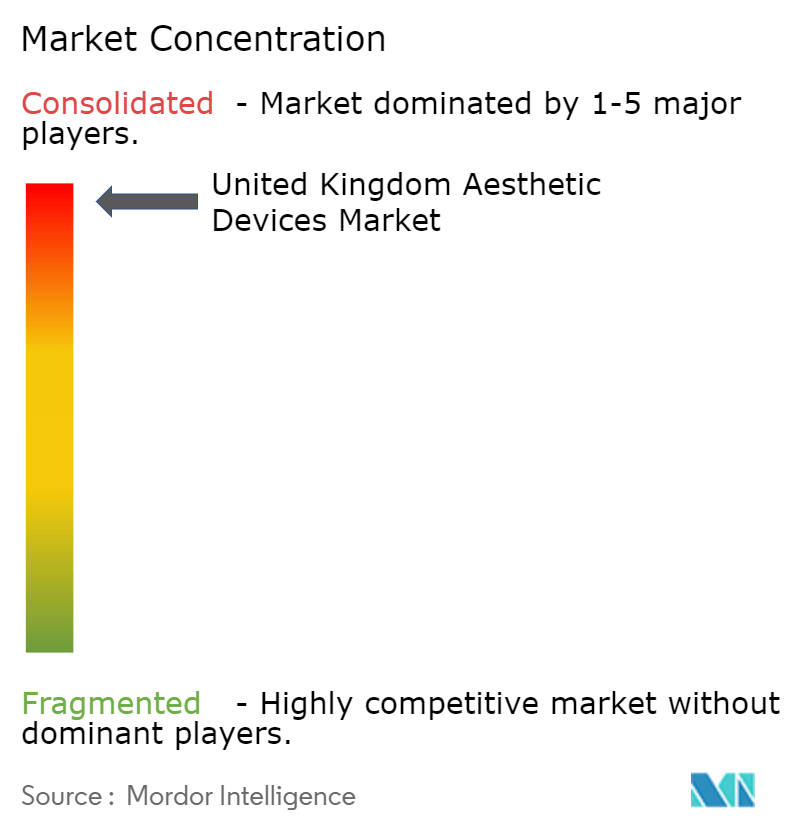
United Kingdom Aesthetic Devices Market News
- September 2024: Clinic Sese Clinches the Title of Best Regenerative Aesthetics Clinic in the United Kingdom for 2024. The recognition is rooted from the treatment offerings towards the advanced anti-aging aesthetics, wellness, weight loss, and women's health.
- September 2023: The United Kingdom government initiated a consultation to examine ways to enhance the safety of Botox and other non-surgical cosmetic treatments. The consultation lasted for 8 weeks. This initiative comes in the wake of the Health and Care Act's passage in April 2022, which empowered the Health and Social Care Secretary to establish a licensing regime.
UK Aesthetic Devices Market Report - Table of Contents
1. INTRODUCTION
- 1.1 Study Assumptions and Market Definition
- 1.2 Scope of the Study
2. RESEARCH METHODOLOGY
3. EXECUTIVE SUMMARY
4. MARKET DYNAMICS
- 4.1 Market Overview
-
4.2 Market Drivers
- 4.2.1 Increasing Obese Population
- 4.2.2 Increasing Awareness about Aesthetic Procedures
- 4.2.3 Rapidly Increasing Aging Population
- 4.2.4 Rapid Technological Advancements
-
4.3 Market Restraints
- 4.3.1 Stringent Safety Regulations for Aesthetic Procedures
- 4.3.2 Reimbursement Issues
-
4.4 Porter's Five Forces Analysis
- 4.4.1 Threat of New Entrants
- 4.4.2 Bargaining Power of Buyers/Consumers
- 4.4.3 Bargaining Power of Suppliers
- 4.4.4 Threat of Substitute Products
- 4.4.5 Intensity of Competitive Rivalry
5. MARKET SEGMENTATION (Market Size by Value - in USD)
-
5.1 By Type of Device
- 5.1.1 Energy-based Aesthetic Device
- 5.1.1.1 Laser-based Aesthetic Device
- 5.1.1.2 Radiofrequency (RF)-based Aesthetic Device
- 5.1.1.3 Light-based Aesthetic Device
- 5.1.1.4 Ultrasound Aesthetic Device
- 5.1.2 Non-energy Based Aesthetic Device
- 5.1.2.1 Botulinum Toxin
- 5.1.2.2 Dermal Fillers and Aesthetic Threads
- 5.1.2.3 Chemical Peels
- 5.1.2.4 Microdermabrasion
- 5.1.2.5 Implants
- 5.1.2.5.1 Facial Implants
- 5.1.2.5.2 Breast Implants
- 5.1.2.5.3 Other Implants
- 5.1.2.6 Other Aesthetic devices
-
5.2 By Application
- 5.2.1 Skin Resurfacing and Tightening
- 5.2.2 Body Contouring and Cellulite Reduction
- 5.2.3 Hair Removal
- 5.2.4 Tattoo Removal
- 5.2.5 Breast Augmentation
- 5.2.6 Other Applications
-
5.3 By End User
- 5.3.1 Hospital
- 5.3.2 Clinics
- 5.3.3 Home Settings
6. COMPETITIVE LANDSCAPE
-
6.1 Company Profiles
- 6.1.1 Cynosure Inc.
- 6.1.2 Sisram Medical Ltd (Alma Lasers)
- 6.1.3 Boston Scientific Corporation (Lumenis Inc.)
- 6.1.4 Syneron Medical Ltd (Syneron Candela)
- 6.1.5 Sciton Inc.
- 6.1.6 Bausch Health Companies Inc. (Solta Medical)
- 6.1.7 Venus Concept
- 6.1.8 Quanta System
- 6.1.9 Cutera Inc.
- 6.1.10 Cosmeditech
- *List Not Exhaustive
7. MARKET OPPORTUNITIES AND FUTURE TRENDS
** Subject To AvailablityUnited Kingdom Aesthetic Devices Industry Segmentation
As per the scope of the report, medical aesthetic devices refer to medical devices that are used for various cosmetic procedures. This includes plastic surgery, unwanted hair removal, excess fat removal, anti-aging, aesthetic implants, skin tightening, etc., which are used for beautification, correction, and improvement of the body.
The UK aesthetic devices market is segmented by type of device, application, and end user. By type of device, the market is segmented into energy-based aesthetic devices non-energy-based aesthetic devices and other aesthetic devices. By energy-based aesthetic devices, the market is segmented into laser-based aesthetic devices, radiofrequency (RF)-based aesthetic devices, light-based aesthetic devices, and ultrasound aesthetic devices. By non-energy-based aesthetic devices, the market is segmented into botulinum toxin, dermal fillers, and aesthetic threads, chemical peels, microdermabrasion, implants. By implants, the market is segmented into facial implants, breast implants, and other implants. By application, the market is segmented into skin resurfacing and tightening, body contouring and cellulite reduction, hair removal, tattoo removal, breast augmentation, and other applications. By end user, the market is segmented into hospitals, clinics, and home settings. The report offers the value (USD) for all the above segments.
| By Type of Device | Energy-based Aesthetic Device | Laser-based Aesthetic Device | |
| Radiofrequency (RF)-based Aesthetic Device | |||
| Light-based Aesthetic Device | |||
| Ultrasound Aesthetic Device | |||
| By Type of Device | Non-energy Based Aesthetic Device | Botulinum Toxin | |
| Dermal Fillers and Aesthetic Threads | |||
| Chemical Peels | |||
| Microdermabrasion | |||
| Implants | Facial Implants | ||
| Breast Implants | |||
| Other Implants | |||
| Other Aesthetic devices | |||
| By Application | Skin Resurfacing and Tightening | ||
| Body Contouring and Cellulite Reduction | |||
| Hair Removal | |||
| Tattoo Removal | |||
| Breast Augmentation | |||
| Other Applications | |||
| By End User | Hospital | ||
| Clinics | |||
| Home Settings |
UK Aesthetic Devices Market Research FAQs
How big is the United Kingdom Aesthetic Devices Market?
The United Kingdom Aesthetic Devices Market size is expected to reach USD 512.72 million in 2024 and grow at a CAGR of 8.91% to reach USD 785.62 million by 2029.
What is the current United Kingdom Aesthetic Devices Market size?
In 2024, the United Kingdom Aesthetic Devices Market size is expected to reach USD 512.72 million.
Who are the key players in United Kingdom Aesthetic Devices Market?
Sciton Inc., Syneron Medical Ltd (Syneron Candela), Sisaram Medical (Alma Lasers), Boston Scientific Corporation (Lumenis Inc.) and Cynosure Inc. are the major companies operating in the United Kingdom Aesthetic Devices Market.
What years does this United Kingdom Aesthetic Devices Market cover, and what was the market size in 2023?
In 2023, the United Kingdom Aesthetic Devices Market size was estimated at USD 467.04 million. The report covers the United Kingdom Aesthetic Devices Market historical market size for years: 2019, 2020, 2021, 2022 and 2023. The report also forecasts the United Kingdom Aesthetic Devices Market size for years: 2024, 2025, 2026, 2027, 2028 and 2029.
UK Aesthetic Devices Industry Report
Statistics for the 2024 UK Aesthetic Devices market share, size and revenue growth rate, created by Mordor Intelligence™ Industry Reports. UK Aesthetic Devices analysis includes a market forecast outlook to 2029 and historical overview. Get a sample of this industry analysis as a free report PDF download.



